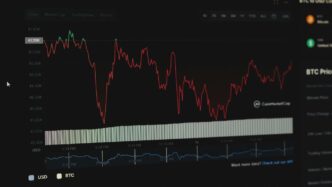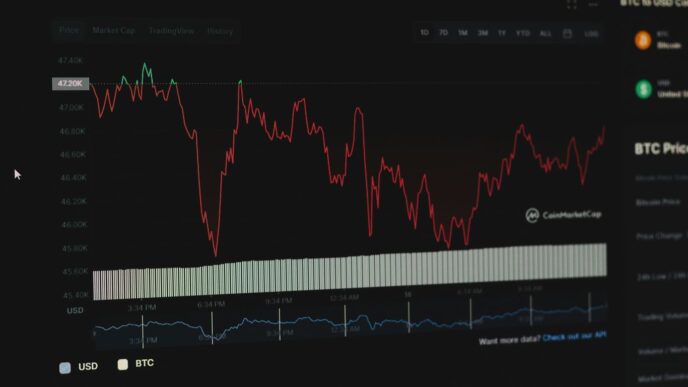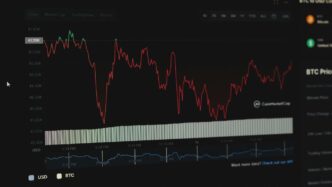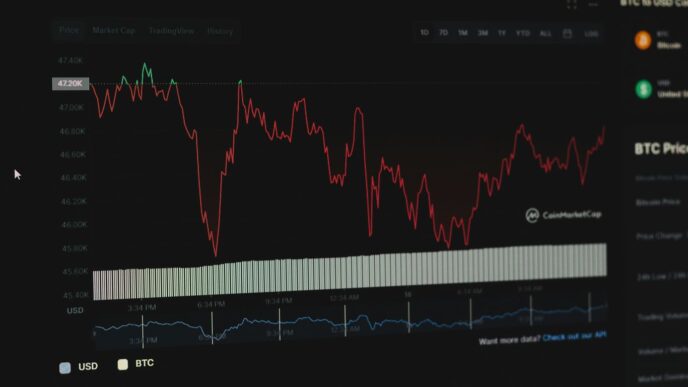So, you’ve probably heard about the 10 Year Treasury Yield, especially if you watch CNBC. It might sound like some complicated finance stuff, but it actually matters a lot for your money. This article is going to break down what it is, why it moves around, and how those movements can hit your investments. We’ll also look at what the Fed is doing and how big economic news can change things. Basically, we’re trying to figure out how to keep your portfolio in good shape no matter what the 10 year treasury cnbc does.
Key Takeaways
- Long-term Treasury yields, like those on 20- and 30-year bonds, have been over 5.1% lately, showing there’s still a lot of uncertainty about the U.S. economy.
- One expert on CNBC even said the U.S. might be heading into an “emerging markets trap” because yields keep going up.
- Some investors are now looking to put their fixed income money into other countries to spread out their risk.
- Bond prices and yields always move in opposite ways, so when bonds sell off, yields go up. This has been happening with U.S. Treasurys, partly because of a recent credit downgrade and worries about government spending.
- The 10 year treasury cnbc yield can drop when the Federal Reserve hints at cutting interest rates, especially if inflation seems to be cooling down.
Understanding the 10 Year Treasury Yield
The 10-year Treasury yield is a benchmark interest rate that reflects the market’s outlook on the U.S. economy and inflation. It’s the yield investors demand for lending money to the U.S. government for a period of 10 years. This yield influences a wide range of other interest rates, including mortgages, corporate bonds, and even some savings accounts. It’s a key indicator that everyone from Wall Street traders to Main Street consumers keeps an eye on.
What Drives Treasury Yield Fluctuations
Treasury yields don’t just sit still; they’re constantly moving based on a variety of factors. Economic data releases, like inflation reports and employment figures, can cause significant swings. For example, if inflation comes in higher than expected, yields tend to rise as investors demand more compensation for the eroding purchasing power of their investment. Similarly, strong economic growth can also push yields higher, as it suggests the Federal Reserve might raise interest rates to prevent the economy from overheating. Geopolitical events, changes in investor sentiment, and even global economic conditions can also play a role. It’s a complex interplay of forces that determines where yields ultimately land. Keep an eye on top tech stocks to see how they react to these fluctuations.
The Relationship Between Bond Prices and Yields
Bond prices and yields have an inverse relationship. This means that when bond prices go up, yields go down, and vice versa. Think of it like a seesaw: one side goes up, the other goes down. Here’s why: when demand for bonds increases, investors are willing to pay more for them, driving up the price. However, the fixed interest payment (coupon) that the bond pays remains the same. As a result, the yield, which is the return on investment, decreases. Conversely, if investors sell off bonds, prices fall, and yields rise to attract buyers. This relationship is crucial to understand when analyzing the Treasury market.
Key Factors Influencing the 10 Year Treasury CNBC
Several key factors, often discussed on CNBC, influence the 10-year Treasury yield:
- Inflation Expectations: If investors expect inflation to rise, they’ll demand a higher yield to compensate for the loss of purchasing power.
- Economic Growth: Strong economic growth typically leads to higher yields, as it suggests the Fed may raise interest rates.
- Federal Reserve Policy: The Fed’s actions, such as raising or lowering interest rates or engaging in quantitative easing, have a direct impact on Treasury yields.
- Global Economic Conditions: Economic conditions in other countries can also influence U.S. Treasury yields, particularly during times of global uncertainty.
- Fiscal Policy: Government spending and tax policies can affect the supply of Treasuries and overall economic growth, impacting yields.
Impact on Investor Portfolios
How Rising Yields Affect Fixed Income
Okay, so yields are going up. What does that actually mean for your fixed income stuff? Well, when Treasury yields rise, existing bonds become less attractive. This is because newly issued bonds offer higher interest payments, making older, lower-yielding bonds less desirable. It’s like seeing a new phone come out with better features – suddenly, your old one isn’t quite as cool. Bond prices and yields move in opposite directions. So, if you’re holding bonds and yields jump, the market value of your bonds will likely decrease. This is especially true for bonds with longer maturities.
Implications for Equity Markets
Rising Treasury yields can also send ripples through the stock market. Higher yields can make bonds a more appealing alternative to stocks, especially for investors looking for safer, income-generating assets. This can lead to some investors shifting money out of stocks and into bonds, potentially causing stock prices to fall. Also, higher yields can increase borrowing costs for companies, which can hurt their profits and slow down economic growth. It’s a bit of a balancing act, though. Sometimes, rising yields reflect a strong economy, which can be good for stocks. But if yields rise too quickly, it can spook investors and trigger a market correction. It’s something to keep an eye on, for sure. Some investors are rethinking the rest of the world because of this.
Diversifying Your Portfolio Amidst Yield Changes
So, what can you do to protect your portfolio when yields are all over the place? Diversification is key. Don’t put all your eggs in one basket. Here are a few ideas:
- Mix it up: Consider adding different types of assets to your portfolio, like stocks, bonds, real estate, and commodities. This can help reduce your overall risk.
- Go global: Investing in international markets can provide diversification and potentially higher returns. As one strategist mentioned to CNBC, the U.S. is staring into an "emerging markets trap" as yields continue to rise, so emerging markets might be a good idea.
- Shorten maturities: If you’re worried about rising yields, consider investing in bonds with shorter maturities. These bonds are less sensitive to interest rate changes.
- Consider alternative investments: Explore options like private equity, hedge funds, or real estate. These investments can offer different risk-return profiles and may not be as correlated with traditional assets.
Basically, don’t panic. Stay calm, re-evaluate your risk tolerance, and make adjustments as needed. It’s all part of the investing game.
Federal Reserve Policy and Treasury Yields
The Fed’s Role in Yield Movements
The Federal Reserve plays a big role in how Treasury yields move. It’s not always a direct thing, but their actions and words definitely have an impact. The Fed’s monetary policy, especially its control over the federal funds rate, influences short-term interest rates, which then ripple through the yield curve. When the Fed raises rates, it generally pushes short-term Treasury yields higher. This is because investors demand a higher return to compensate for the increased risk of holding bonds in a rising rate environment. Conversely, when the Fed lowers rates, yields tend to fall. It’s like a see-saw; one goes up, the other goes down. The Fed also uses tools like quantitative easing (QE) and quantitative tightening (QT), which involve buying or selling government bonds to influence the money supply and, consequently, yields. For example, the Fed’s monetary policy can influence investor sentiment.
Interest Rate Decisions and Their Effects
Interest rate decisions made by the Federal Open Market Committee (FOMC) are closely watched by everyone. These decisions don’t just happen in a vacuum; they’re based on a ton of economic data and forecasts. When the Fed announces a rate hike, it’s usually because they’re trying to cool down an overheating economy and combat inflation. This often leads to higher Treasury yields across the board. On the other hand, if the Fed cuts rates, it’s usually a sign that they’re worried about economic growth and want to stimulate borrowing and investment. This typically results in lower yields. The market’s reaction to these decisions can be pretty intense, with yields sometimes moving sharply in either direction depending on whether the announcement was expected or not. It’s all about expectations and how the market interprets the Fed’s intentions. Here’s a quick look at how different rate decisions might affect yields:
- Rate Hike: Yields generally increase, especially on short-term Treasuries.
- Rate Cut: Yields generally decrease, providing a boost to bond prices.
- No Change: Market reaction depends on the accompanying statement; hawkish (inflation-focused) statements might lead to slight yield increases, while dovish (growth-focused) statements might lead to slight decreases.
Anticipating Future Fed Actions on the 10 Year Treasury CNBC
Trying to predict what the Fed will do next is a favorite pastime for many investors. It’s not easy, but there are some things to watch. Economic indicators like inflation, employment, and GDP growth are key. The Fed also pays close attention to global economic conditions and financial market stability. Analyst opinions and forecasts can also provide some insight, but it’s important to remember that they’re just opinions. The Fed’s own statements and minutes from FOMC meetings can offer clues about their thinking and potential future actions. However, the market’s expectations play a big role too. If the market is already pricing in a certain action, the actual announcement might not have as big of an impact. Staying informed and considering multiple sources of information is crucial for forecasting the path of the 10 Year Treasury.
Economic Indicators and Yield Performance
Inflation’s Influence on Treasury Yields
Inflation is a big deal when it comes to Treasury yields. Generally, when inflation goes up, Treasury yields follow suit. This is because investors demand a higher return to compensate for the erosion of purchasing power. Think about it: if you’re lending money for 10 years, you want to make sure you’re still getting a good deal after inflation eats away at it. The Consumer Price Index (CPI) and the Producer Price Index (PPI) are two key indicators to watch. If these numbers start climbing, expect upward pressure on the 10 year treasury.
Fiscal Spending and Market Reactions
Government spending can also impact Treasury yields. When the government increases spending, it often needs to borrow more money by issuing more bonds. This increased supply can push bond prices down, which in turn, drives yields up. The size and nature of the spending matter too. Big infrastructure projects might have a different effect than, say, increased social welfare programs. It’s all about supply and demand in the bond market, and government fiscal policy plays a significant role. Keep an eye on announcements about government spending and how the market reacts.
Credit Downgrades and Their Impact on the 10 Year Treasury CNBC
A credit downgrade is when a rating agency, like Moody’s or S&P, lowers its assessment of a country’s creditworthiness. This can spook investors and lead to a sell-off in government bonds. When investors dump bonds, prices fall, and yields rise. It’s a sign that the market is losing confidence in the government’s ability to repay its debt. A downgrade can have a ripple effect, impacting other areas of the economy as well. Here are some potential impacts:
- Increased borrowing costs for the government.
- Higher yields on long-dated treasurys.
- Potential for capital flight as investors seek safer havens.
- Weakening of the national currency.
Strategic Investment Approaches
Adjusting Fixed Income Allocations
Okay, so the 10-year Treasury yield is doing its thing, right? What does that even mean for your bond holdings? Well, if yields are climbing, your existing bonds might take a little hit. The trick is to think about how long you want to hold those bonds. If you’re in it for the long haul, maybe just ride it out. But if you’re closer to needing that cash, you might consider shortening the duration of your fixed income allocation. This means swapping longer-term bonds for shorter-term ones. You won’t get as much yield, but you’ll be less sensitive to those interest rate swings. It’s all about finding that sweet spot between risk and return, you know?
Considering International Diversification
Don’t put all your eggs in one basket, as they say! When US Treasury yields get a little wild, it might be time to peek at what’s happening overseas. Other countries have their own bond markets, and sometimes, they’re moving in completely different directions. Investing in international bonds can give you a bit of a buffer against whatever’s happening here at home. Plus, you get exposure to different economies and currencies. Just remember, it also adds a layer of complexity, so do your homework or talk to someone who knows their stuff. Here’s a few things to consider:
- Currency Risk: Exchange rates can eat into your returns, or boost them!
- Political Stability: Some countries are riskier than others.
- Tax Implications: International investments can get tricky when tax season rolls around.
Navigating Volatility in the 10 Year Treasury CNBC Market
Let’s be real, the bond market can be a rollercoaster, especially when the 10-year Treasury is making headlines. One day, yields are up; the next, they’re down. It’s enough to make your head spin! So, how do you keep your cool? First, remember your long-term goals. Don’t panic sell just because things get bumpy. Second, consider using tools like dollar-cost averaging. This means investing a fixed amount of money at regular intervals, no matter what the market is doing. That way, you buy more when prices are low and less when prices are high. Finally, don’t be afraid to sit on the sidelines for a bit. Sometimes, the best move is to do nothing at all. Keep an eye on analyst perspectives and don’t make rash decisions.
Market Sentiment and Future Outlook
Analyst Perspectives on Yield Trends
Okay, so what are the people who get paid to think about this stuff actually saying? Well, it’s a mixed bag, honestly. Some analysts are pretty convinced that yields will keep climbing, pointing to persistent inflation and the Fed’s hawkish stance. They think we might even see the 10-year Treasury bonds hit levels we haven’t seen in years. Others are more cautious. They argue that economic growth is slowing, and that could put a lid on how high yields can go. Plus, there’s always the chance of some unexpected event – a geopolitical crisis, a surprise economic report – that could throw everything off course. It’s kind of like trying to predict the weather; you can look at all the data, but you never really know for sure.
Investor Confidence and Market Behavior
Investor confidence is a huge driver of market behavior, and right now, it’s… complicated. You’ve got some investors who are still pretty bullish, betting that the economy will keep chugging along and that corporate earnings will remain strong. But there’s also a lot of nervousness out there. People are worried about inflation, about the Fed raising rates too aggressively, and about the possibility of a recession. That uncertainty is leading to a lot of volatility in the market, with investors jumping in and out of positions as the news changes. It’s a tough environment to navigate, and it’s making it hard to get a clear read on where things are headed. One thing is for sure: fear can be a self-fulfilling prophecy. If enough people get scared, they’ll pull their money out of the market, which can then cause the very downturn they were worried about.
Forecasting the Path of the 10 Year Treasury CNBC
Trying to predict where the 10-year Treasury yield is going is basically a guessing game, but here are some factors to keep in mind:
- Inflation Data: Keep a close eye on the Consumer Price Index (CPI) and the Producer Price Index (PPI). If inflation stays high, yields will likely keep climbing.
- Federal Reserve Actions: The Fed’s decisions on interest rates will have a big impact. If they keep raising rates, yields will probably go up. If they pause or even start cutting rates, yields could fall.
- Economic Growth: Watch for signs of a slowdown in the economy. If growth starts to weaken, yields could decline as investors seek safety in Treasury bonds.
- Global Events: Geopolitical risks and other global events can also influence yields. A crisis in another country could send investors flocking to U.S. Treasuries, pushing yields down.
Ultimately, nobody knows for sure where the 10-year Treasury yield is headed. But by paying attention to these factors, you can at least make a more informed guess. And remember, diversification is key. Don’t put all your eggs in one basket, especially in a volatile market like this.
Historical Context of Treasury Yields
Past Trends in Long-Dated Treasurys
Looking back, long-dated Treasury yields have seen some wild swings. It’s not always a smooth ride. We’ve had periods of steady decline, like after the dot-com bubble burst, and then sudden spikes during economic booms. Understanding these past movements can give us clues, but it’s never a perfect predictor of the future.
Lessons from Previous Market Cycles
Market cycles are like seasons – they change. One thing I’ve learned is that what worked in one cycle might not work in the next. For example, during the 2008 financial crisis, everyone piled into Treasurys for safety, driving yields down. Now, with inflation concerns, the reaction might be different. Here are a few lessons I’ve picked up:
- Don’t assume history will repeat itself exactly.
- Pay attention to the underlying economic conditions.
- Diversification is always a good idea.
Comparing Current Yields to Historical Averages on CNBC
So, where do we stand today? Well, comparing current Treasury yields to historical averages on CNBC can be insightful. Are we above, below, or right in line with the norm? This gives context. But remember, averages can be misleading. Averages smooth out the peaks and valleys, and right now, we might be heading for a peak. It’s like saying the average temperature in July is 80 degrees, but that doesn’t tell you about the days it hits 100. Here’s a quick comparison:
| Time Period | Average 10-Year Treasury Yield | Notes |
|---|---|---|
| 1980s | 10.5% | High inflation era |
| 2000s | 4.5% | Dot-com bust, housing boom |
| 2010s | 2.5% | Post-financial crisis, low growth |
| Today (6/29/2025) | 4.6% | Recovering from pandemic, inflation concerns |
Conclusion
So, what’s the takeaway here? The 10-year Treasury yield is a big deal for your money. It’s not just some number on a screen. It tells us a lot about what’s going on with the economy and where things might be headed. Keeping an eye on it can help you make smarter choices with your investments. It’s all about understanding how these things connect to your own financial picture. Stay informed, and you’ll be in a better spot to handle whatever comes next.
Frequently Asked Questions
What exactly is the 10-year Treasury yield?
The 10-year Treasury yield is like the interest rate the U.S. government pays when it borrows money for ten years. It’s a really important number because it tells us how much investors expect the economy to grow and what they think about future inflation. When this yield goes up, it often means investors are feeling good about the economy, but it can also make borrowing money more expensive for everyone.
How does a rising 10-year Treasury yield affect my everyday money?
When the 10-year Treasury yield climbs, it can make it harder for regular folks to get loans for things like houses or cars because banks often base their loan rates on this yield. For businesses, it means borrowing money for new projects costs more, which might slow down their growth. This can also make stocks less appealing, as bonds start to offer better returns.
What causes the 10-year Treasury yield to change?
The Federal Reserve, which is like the country’s central bank, plays a big role. When they decide to raise or lower their main interest rate, it usually makes the 10-year Treasury yield move in the same direction. What the Fed says about the economy and their plans for the future also has a huge impact on what investors expect, which then changes the yield.
Does inflation have an effect on the 10-year Treasury yield?
When prices for goods and services go up (which is called inflation), investors usually want a higher yield on their bonds to make sure their money still buys as much in the future. So, if inflation is expected to rise, the 10-year Treasury yield often goes up too. It’s all about investors wanting to protect their buying power.
What does this yield mean for my investment portfolio?
For people who own bonds, a higher yield usually means the value of their existing bonds goes down. For stock investors, it can be a mixed bag. Some companies might struggle if borrowing costs go up, but others might do well if the economy is strong enough to support higher rates. It’s important to have a mix of different investments to handle these changes.
Why should I care about the 10-year Treasury yield?
Keeping an eye on the 10-year Treasury yield is smart because it’s a good sign of what’s happening in the economy. It can help you understand why interest rates are changing and how that might affect your savings, loans, and investments. Knowing about it can help you make better choices with your money.














